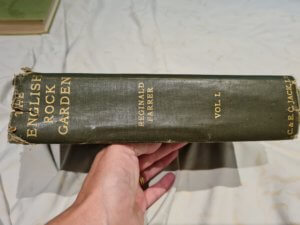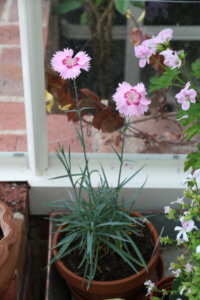Dianthus are a stunning array of really pretty plants and yet in three decades of gardening they’ve never really registered with me. Recently I’ve started growing a few and I’m hooked, not least because the scent of many dianthus remind me of my grandmother’s downstairs cloakroom. A combination of musky soap and floral air freshener.
Most of the varieties I grow come under the umbrella term of ‘Garden Pinks’, a name derived from the jagged edges of the flowers rather than their colour. According to my dictionary the verb ‘to pink’ means to “cut a scalloped or zig zag on (a raw fabric edge)”. This is the origin of pinking shears of course and the zig zag or ragged edges are a feature shared to a greater or lesser extent by garden dianthus.
This post aims to show how versatile these plants are – suitable for rock gardens, troughs, containers or the front of a border.
Dianthus and Reginald Farrer

First a bit of history. Reginald Farrer was a botanist and alpine collector who has no particular association with dianthus except that there were few plants that he knew nothing about and many many plants he knew much about, including dianthus.
When I want to know about a particular plant I often go to my second hand copy of his book, The English Rock Garden. This two volume tome was first published just after WWI and is a wordy but enthralling set of descriptions of mainly alpine plants and their cultivation techniques.

He didn’t let me down on dianthus. His opening paragraph confirmed what I sort of suspected – that even in Farrer’s day there was much confusion surrounding the different species and how to identify each one. Farrer says of dianthus “In no race is there more confusion and in no race is there are larger proportion of second or third rate species”.
His densely packed, wordy paragraphs contain gems of phrases and his description of Dianthus runs to 22 pages. Pity poor Dianthus cyri, written off as a “worthless wed”.
Farrer describes only species dianthus but modern breeding techniques have taken the genetics of the best of the species and bred some really beautiful and useful dianthus hybrids. Here I feature a species variety – dianthus gracilis, and then some hybrids – some named some anonymous, to show you how beautiful and useful they are in a number of garden situations.
Dianthus gracilis
 I have many attractive hummocks of D. gracilis in my rock garden, raised from seed sourced from the Alpine Garden Society seed exchange.
I have many attractive hummocks of D. gracilis in my rock garden, raised from seed sourced from the Alpine Garden Society seed exchange.
Farrer’s words on dianthus gracilis give the impression that he wasn’t massively enthralled by this particular species, although he seems to like the bright pink of the flowers. Mine are now waning in flower but have delighted me for two months or more.
Many garden pinks have very grey foliage but gracilis has fresh green leaves over which a constellation of shocking cerise flowers dance in the breeze.
Some more Rock Garden Pinks

Dianthus Whatfield Can Can
At the beginning of this growing season I bought in several new plants to fill gaps in the garden. Making my purchases from two nurseries – Pottertons and Alpine and Grasses I have a few small dianthus hybrid varieties suitable for rockeries, troughs and other containers. Most are just going over as July nears its close but have been entertaining throughout late May and June.

Dianthus ‘Whatfield Can Can’

Dianthus ‘Inschriach Dazzler’

Dianthus ‘Night Star’ AGM
None of these were available in Farrer’s day, his book describing only species available across the world in the wild. Who knows what he would have thought of these hybrids but I’m pretty keen on them.
Dianthus in containers

Dianthus in containers
Kindly ignore the slug-damaged hosta in this urn and focus instead on the pale pink and shocking pink dwarf Pinks. These I planted three years ago. They have survived not only the competition from the hostas but also a fair amount of neglect on my part. I can’t remember ever feeding them, have never repotted them and don’t always get round to them with my watering can. Yet still they prevail flowering away for the summer.
They have no name I’m afraid but were bought in a garden centre from the bedding plant section. I include them here as evidence of the usefulness of these perennial dwarf hybrid dianthus. If you’re looking for a perennial pot display what could be better than these?
Dianthus ‘Shirley Temple’

Dianthus Shirley Temple

Dianthus in containers
We’re moving on to some larger flowered Dianthus now. Reginald Farrer died twelve years before Shirley Temple was born and almost a century before this dianthus was bred. I’m wondering what he’d have made of it?
I’m very keen on it – the candy floss toned petals are edged with the classic dishevelled cinderella skirt edges and have a charming magenta swirl towards the centre.
I’m growing it very successfully in a pot in the greenhouse where it is raised on a table to admire its lovely form.
It turns out this is named after the Shirley Temple cocktail, in turn named after the actress. These are part of a set of 5 cocktail themed dianthus, more of which I share below.
Dianthus Cocktail Mix

Dianthus Tequila Sunrise

Dianthus Cosmopolitan

Dianthus Mojito

Dianthus Cherry Brandy
Mojito anyone? or maybe you’re more of a Cosmopolitan type? This Season, Sarah Raven was selling a set of 5 dianthus ‘Cocktail Mix’ with large open faces, 3-4cm in diameter. They’ve taken their time to develop but are now putting on a show. Cherry Brandy, like Shirley Temple, is growing in a pot. Cosmopolitan, Mojito and Tequila Sunrise are at the front of a border. What’s your favourite?
This seasonal diary is part of a weekly link-up of garden bloggers from around the world, called Six on Saturday. For more information and links to other blogs crammed with gardening activity, check the blog of host The Propagator.





Hmm, I’m going to have too look into that cocktail mix. Lovely, especially Mojito with its unusual green centre. I have a variety called ‘Pink Kisses’ that has been going for a few years in a pot. They always remind me of my Nana who used to grow pinks/carnations in her front garden.
Hi Graeme – you know I think Mojito is my favourite too as it’s so unusual-looking.
Lovely, lovely, lovely! But what I want to know is, what other treasures lie in your garden library?
Hi Gill – so pleased you enjoyed the read. Most of my books are modern but I do have a couple of older ones on my shelf. This two volume Farrer book was being sold off at RHS Wisley as they were having a library clear-out a couple of years ago. I’m sure they had a few copies of this one as it was a popular book when published. My oldest book was given to me by my Father when he died. It’s a leather bound book called the Muck Manual and contains loads of old recipes for composts and natural fertilisers. It’s a tremendous book and much cherished.
I love pinks, and I enjoyed reading your post. I recently read a book on Farrer, more like a Biography, but it made interesting reading: A Rage for Rock Gardening.
That sounds like my kind of book – I’ll look out for it. I love reading about the early pioneers of gardening. Farrer was so knowledgeable and whilst some things have moved on, many of his observations still hold true today.
Very good choice to highlight the dianthus! The last 4 photos are a success and it makes me want to grow more …
I think there’s a place for them in any garden. Those last 4 make excellent specimens for the front of a border.
I love dianthus – particularly the scent. I don’t have any in the garden as I thought they would dislike my clay soil which is on the acid side. I have one in the greenhouse. I’ll have to try some more. I enjoyed seeing your old book and I agree with all those previous comments that Mojito is a very lovely example.